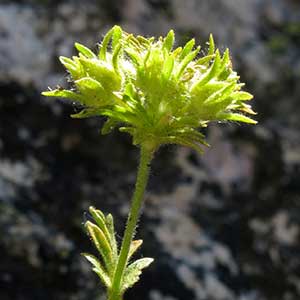Ivesia longibracteata
Ivesia tweedyi
Castle Crags ivesia, longbract mousetail
Tweedy's ivesia, Tweedy's mousetail
ascending to erect, 0.3–1.2 dm.
ascending to erect, 0.4–2(–3.5) dm.
weakly planar to loosely ± cylindric, (0.5–)2–4(–6) cm; sheathing base glandular abaxially, otherwise glabrous;
petiole 0.5–2 cm, hairs 0.2–1 mm;
leaflets 5–6 per side, 2–6 mm, ± short-hirsute, glandular-puberulent, lobes 2–7, oblanceolate to spatulate or obovate, apex not setose.
loosely cylindric, (3–)4–12(–17) cm; sheathing base glabrous abaxially;
petiole 0.5–7 cm, hairs 1–1.5 mm;
leaflets 10–16 per side, 4–7(–10) mm, glabrous or sparsely hirsute, glandular-puberulent or -pubescent, lobes (2–)5–15, linear to narrowly oblanceolate, apex not setose.
1–3, not paired.
(0–)1–2, not paired.
3–14-flowered, 1–2.5 cm diam.;
glomerules 1.
(5–)10–25(–35)-flowered, (1–)1.5–3(–4.5) cm diam.;
glomerules 1–few.
1.5–6 mm.
1–3(–5) mm.
8–10 mm diam.;
epicalyx bractlets linear to narrowly lanceolate or elliptic, 2.5–5 mm, longer than sepals;
hypanthium shallowly cupulate, 0.5–1 × 2–3 mm;
sepals 1.5–2.5 mm, ± acute;
petals pale yellow, linear to narrowly oblanceolate, 1.5–2.5 mm;
stamens 5, filaments 0.7–1.3 mm, anthers yellow, 0.5–0.8 mm;
carpels 6–11, styles 1–1.5 mm.
9–12 mm diam.;
epicalyx bractlets linear, 1–2 mm;
hypanthium shallowly campanulate, 1–1.5 × 2–4(–5.5) mm;
sepals 2–3.5 mm, acute;
petals golden yellow, broadly elliptic to spatulate, 2.5–3.3 mm;
stamens 5, filaments 1–1.7 mm, anthers yellow, 0.5–0.8 mm;
carpels (2–)4–6(–9), styles 2–3 mm.
cream to light tan, 1.2–1.5 mm.
olive green, 1.8–2 mm.
Ivesia longibracteata
Ivesia tweedyi
Of conservation concern.
Ivesia longibracteata is known only from the Castle Crags area of Shasta County. The epithet alludes to a diagnostic characteristic unique in the genus: the epicalyx bractlets are longer than the sepals. The plants grow on vertical rock faces, a habitat more characteristic of sect. Setosae; however, the stems are ascending to erect and do not form hanging clumps, and the pedicels are not curved in fruit.
(Discussion copyrighted by Flora of North America; reprinted with permission.)
Of conservation concern.
Ivesia tweedyi is found from the Cascade Range in Washington to Boundary and Shoshone counties in Idaho, barely entering Montana in Mineral County.
(Discussion copyrighted by Flora of North America; reprinted with permission.)


